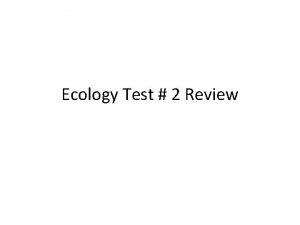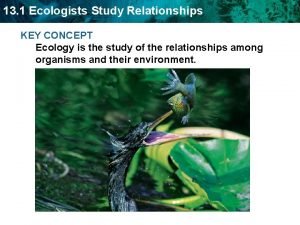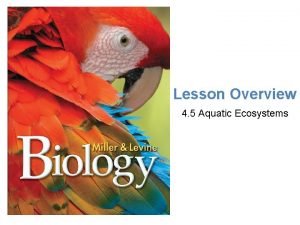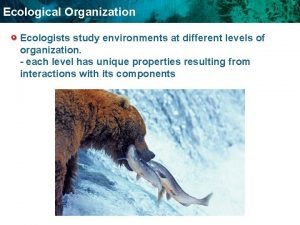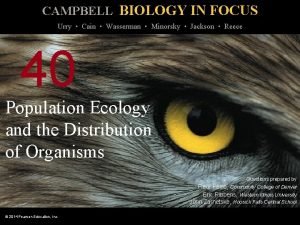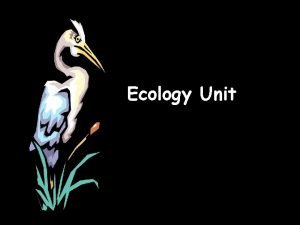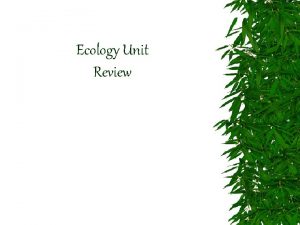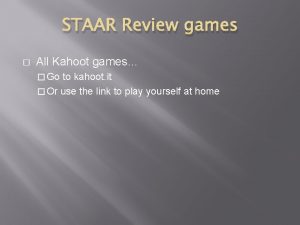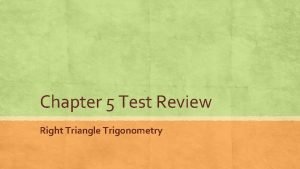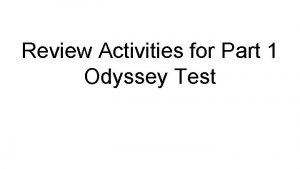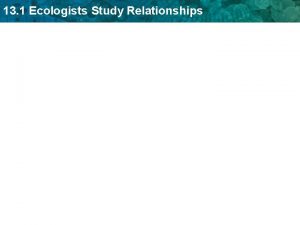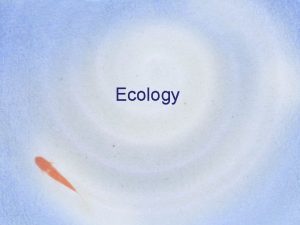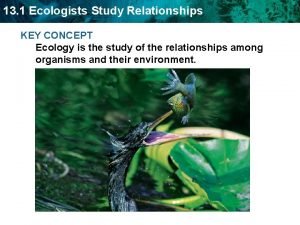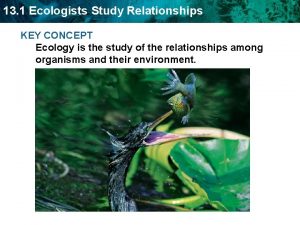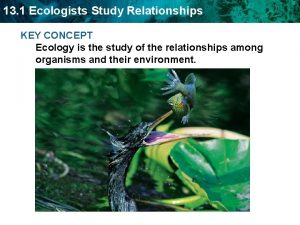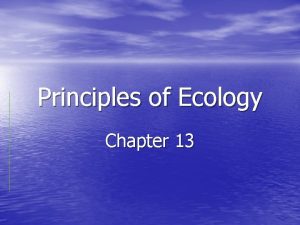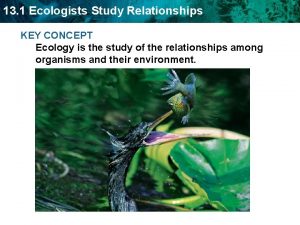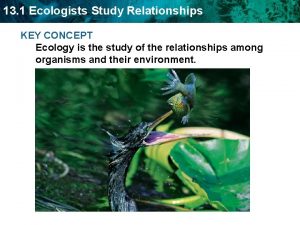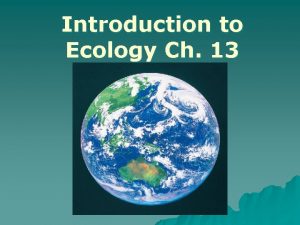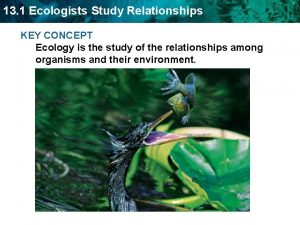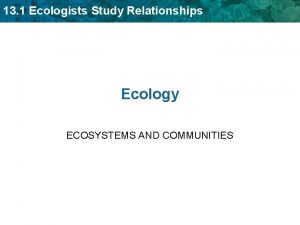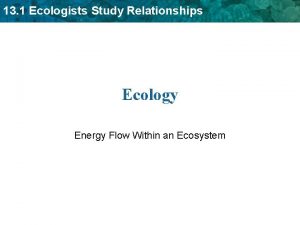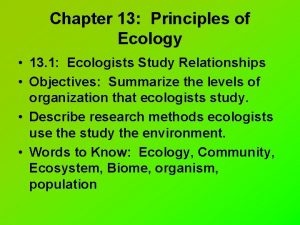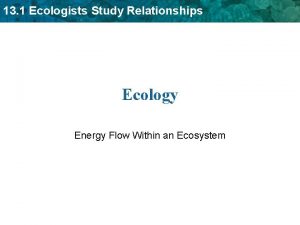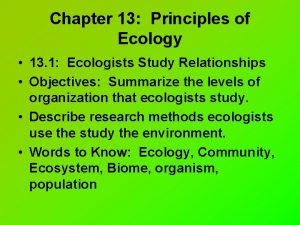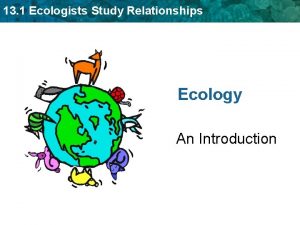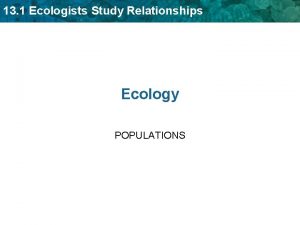Ecology Test 2 Review 1 What do ecologists





























- Slides: 29

Ecology Test # 2 Review

1. What do ecologists call the transfer of energy that begins with the Sun and passes from one organism to the next in a food chain? • Food transfer • Direction of energy • Energy flow • Pyramid of numbers

2. An energy pyramid shows that in an ecosystem…. . • There always a large number of producers at the bottom and fewer top consumers. • There always a large number of top consumers and fewer producers • There an equal number of producers and consumers. • There are more top consumers than primary consumers.

3. A food web is more realistic than a food chain for showing the feeding relationships in ecosystems because…. . • It compares the number of consumers to the number or producers. • A food web is a more complete model of all the feeding relationships in an ecosystem. • A food web explains why there are more producers than consumers. • Producers are usually eaten by many different consumers.

4. One model that shows the direction energy passes from one organism to another organism is called a _____. • An energy link • A food chain • An energy pyramid • A food link

5. Which of the following factors would LEAST effect the carrying capacity of an ecosystem? • Amount of food • Presence of water • Available shelter • Temperature

If the frog population was reduced…. Tell why 6. What would happened to the foxes? 7. What would happened to the snakes? 8. What would happened to the grass? 9. What would happened to the beetles?

1. What do ecologists call the transfer of energy that begins with the Sun and passes from one organism to the next in a food chain? • Food transfer • Direction of energy • Energy flow • Pyramid of numbers

2. An energy pyramid shows that in an ecosystem…. . • There always a large number of producers at the bottom and fewer top consumers. • There always a large number of top consumers and fewer producers • There an equal number of producers and consumers. • There are more top consumers than primary consumers.

3. A food web is more realistic than a food chain for showing the feeding relationships in ecosystems because…. . • It compares the number of consumers to the number or producers. • A food web is a more complete model of all the feeding relationships in an ecosystem. • A food web explains why there are more producers than consumers. • Producers are usually eaten by many different consumers.

4. One model that shows how energy passes from one organism to another organism is called a _____. • An energy link • A food chain • An energy pyramid • A food link

5. Which of the following factors would LEAST effect the carrying capacity of an ecosystem? • Amount of food • Presence of water • Available shelter • Temperature

If the frog population was reduced…. Tell why… 6. What would happen to the foxes? The fox population would decrease… cause foxes eat the frogs… so less food for the foxes.

• 7. What would happened to the snakes? • The snake population would decrease. • The snakes eat frogs… so less frogs. . Means less food for the snakes…

• 8. What would happened to the grass? The grass would decrease…cause frogs eat grasshoppers & beetles… that eat grass. So more grasshoppers & beetles. . less grass.

• 9. What would happen to the beetles? The beetles would increase…cause frogs eat beetles. . So less frogs more beetles.

10. What happens to the amount of energy as you move from D to A? 11. Label each level with the correct term. Primary Consumer Tertiary Consumer Producer Secondary Consumer

12. Group into producers/consumers/decomposers – Hawk – Grass – Rabbit – Snakes – Chipmunks – Squirrels – Acorns – Deer – Eagles – Mice – Beetles – Grasshopper – Fungi

13. Which of these could be primary consumers – Hawk – Grass – Rabbit – Snakes – Chipmunks – Squirrels – Acorns – Deer – Eagles – Mice – Beetles – Grasshopper – Fungi

If the kelp has 5000 kcal of energy… 14. How much is available for the Sea Urchin? 15. How much is available for the Sheephead? 16. How much is available for the Sea Bass?

Using the illustration of an energy pyramid, answer the following questions. 17. Where do the organisms in the first trophic level get their energy from? 18. How much energy from the sun is passed on in each trophic level? 19. Which trophic level is most important? Why? 20. Why is there usually one apex predator?

21. During which years was the moose population 800? 22. Between which years did the moose overshoot their carrying capacity?

Make sure you recognize the two scales. . One for the moose an one for the wolves. . This graph has two scales because the data for each Y-axis needs different scales.

10. What happens to the amount of energy as you move from D to A? Energy decrease 11. Label each level with the correct term. Tertiary consumer- 4 th trophic level Secondary consumer- 3 rd trophic level Primary consumer- 2 nd trophic level Producer- 1 st trophic levle

12. Group into producers/consumers/ decomposers – Hawk (C) – Grass (P) – Rabbit (C) – Snakes (C) – Chipmunks (C) – Squirrels (C) – Acorns (P) – Deer (C) – Eagles (C) – Mice (C) – Beetles(C) – Grasshopper (C) – Fungi (D)

13. Which of these could be primary consumers? – Hawk – Grass – Rabbit – Snakes – Chipmunks – Squirrels – Acorns – Deer – Eagles – Mice – Beetles – Grasshopper – Fungi

If the kelp has 5000 kcal of energy… 14. How much is available for the Sea Urchin? 500 kcal 15. How much is available for the Sheephead? 50 kcal 16. How much is available for the Sea Bass? 5 kcal

Using the illustration of an energy pyramid, answer the following questions. 17. Where do the organisms in the first trophic level get their energy from? The Sun 18. How much energy from the sun is passed on in each trophic level? 10% 19. Which trophic level is most important? Why? Producers, because they make all the energy. 20. Why is there usually one apex predator? Not enough energy.

21. When was the moose population 800? 1965 & 1980 22. Between which years did the moose overshoot their carrying capacity? Between 1995 and 2000
 What do ecologists do
What do ecologists do What do ecologists do
What do ecologists do Section 1 ecologists study relationships
Section 1 ecologists study relationships How do ecologists usually classify marine ecosystems?
How do ecologists usually classify marine ecosystems? What different levels of organization do ecologists study
What different levels of organization do ecologists study Population ecologists are primarily interested in
Population ecologists are primarily interested in Ecology unit review
Ecology unit review Sulfur oxide
Sulfur oxide Algebra 2 unit 1 test
Algebra 2 unit 1 test Honors biology ecology test
Honors biology ecology test Chapter test a chapter 4 population ecology answer key
Chapter test a chapter 4 population ecology answer key Principles of ecology chapter 2 section 2 answer key
Principles of ecology chapter 2 section 2 answer key Chapter review motion part a vocabulary review answer key
Chapter review motion part a vocabulary review answer key Ap gov final review
Ap gov final review Nader amin-salehi
Nader amin-salehi Traditional and systematic review venn diagram
Traditional and systematic review venn diagram Narrative review vs systematic review
Narrative review vs systematic review The tragedy of julius caesar unit test review
The tragedy of julius caesar unit test review The crucible cast of characters
The crucible cast of characters Log to exponetial form
Log to exponetial form Cold war kahoot
Cold war kahoot Test readiness review
Test readiness review Comic relief in romeo and juliet
Comic relief in romeo and juliet Plate tectonics test review answer key
Plate tectonics test review answer key Hamlet unit test answers
Hamlet unit test answers Renaldo and nasreen build an electromagnet
Renaldo and nasreen build an electromagnet Test review right triangle trigonometry answers
Test review right triangle trigonometry answers Who wore human molars as cufflinks
Who wore human molars as cufflinks Odysseus part 1
Odysseus part 1 Renaissance and reformation test
Renaissance and reformation test
